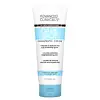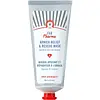What's inside
What's inside
 Key Ingredients
Key Ingredients

 Benefits
Benefits

 Concerns
Concerns

 Ingredients Side-by-side
Ingredients Side-by-side

Aloe Barbadensis Leaf Juice
Skin ConditioningStearic Acid
CleansingGlycerin
HumectantGlyceryl Stearate Se
EmulsifyingCocos Nucifera Oil
MaskingGlyceryl Stearate
EmollientPEG-100 Stearate
Beeswax
Emulsion StabilisingBehenyl Alcohol
EmollientCetyl Alcohol
EmollientAminopropyl Ascorbyl Phosphate
AntioxidantDipotassium Glycyrrhizate
HumectantSimmondsia Chinensis Seed Oil
EmollientButyrospermum Parkii Butter
Skin ConditioningCetearyl Dimethicone
EmollientXanthan Gum
EmulsifyingDisodium EDTA
Sodium Hydroxide
BufferingParfum
MaskingEthylhexylglycerin
Skin ConditioningCaprylyl Glycol
EmollientHexylene Glycol
EmulsifyingPhenoxyethanol
PreservativeAloe Barbadensis Leaf Juice, Stearic Acid, Glycerin, Glyceryl Stearate Se, Cocos Nucifera Oil, Glyceryl Stearate, PEG-100 Stearate, Beeswax, Behenyl Alcohol, Cetyl Alcohol, Aminopropyl Ascorbyl Phosphate, Dipotassium Glycyrrhizate, Simmondsia Chinensis Seed Oil, Butyrospermum Parkii Butter, Cetearyl Dimethicone, Xanthan Gum, Disodium EDTA, Sodium Hydroxide, Parfum, Ethylhexylglycerin, Caprylyl Glycol, Hexylene Glycol, Phenoxyethanol
Water
Skin ConditioningC12-15 Alkyl Benzoate
AntimicrobialGlycerin
HumectantButyrospermum Parkii Butter
Skin ConditioningGlyceryl Stearate
EmollientBehenyl Alcohol
EmollientTheobroma Cacao Seed Butter
EmollientGlyceryl Citrate/Lactate/Linoleate/Oleate
EmulsifyingCannabis Sativa Seed Oil
EmollientCocos Nucifera Oil
MaskingAloe Barbadensis Leaf Juice
Skin ConditioningCetearyl Olivate
Allantoin
Skin ConditioningPhenoxyethanol
PreservativeCaprylyl Glycol
EmollientSorbitan Olivate
EmulsifyingSodium Polyacrylate
AbsorbentPentylene Glycol
Skin ConditioningButylene Glycol
HumectantHydrogenated Polydecene
EmollientXanthan Gum
EmulsifyingNicotiana Tabacum Leaf Oil
PerfumingMelia Azadirachta Leaf Extract
Skin ConditioningTrideceth-6
EmulsifyingTocopheryl Acetate
AntioxidantMelia Azadirachta Flower Extract
Skin ConditioningCoccinia Indica Fruit Extract
Skin ConditioningSolanum Melongena Fruit Extract
Skin ConditioningAloe Barbadensis Flower Extract
EmollientColloidal Oatmeal
AbsorbentCalendula Officinalis Flower Extract
MaskingCamellia Sinensis Leaf Extract
AntimicrobialGlycyrrhiza Glabra Root Extract
BleachingChrysanthemum Parthenium Extract
Skin ConditioningArnica Montana Flower Extract
MaskingCentella Asiatica Extract
CleansingRuscus Aculeatus Root Extract
AstringentHydroxyphenyl Propamidobenzoic Acid
Skin ConditioningOcimum Sanctum Leaf Extract
Skin ConditioningCurcuma Longa Root Extract
MaskingCorallina Officinalis Extract
Skin ConditioningAscorbyl Palmitate
AntioxidantCitric Acid
BufferingLeuconostoc/Radish Root Ferment Filtrate
AntimicrobialPotassium Sorbate
PreservativeSodium Benzoate
MaskingEthylhexylglycerin
Skin ConditioningWater, C12-15 Alkyl Benzoate, Glycerin, Butyrospermum Parkii Butter, Glyceryl Stearate, Behenyl Alcohol, Theobroma Cacao Seed Butter, Glyceryl Citrate/Lactate/Linoleate/Oleate, Cannabis Sativa Seed Oil, Cocos Nucifera Oil, Aloe Barbadensis Leaf Juice, Cetearyl Olivate, Allantoin, Phenoxyethanol, Caprylyl Glycol, Sorbitan Olivate, Sodium Polyacrylate, Pentylene Glycol, Butylene Glycol, Hydrogenated Polydecene, Xanthan Gum, Nicotiana Tabacum Leaf Oil, Melia Azadirachta Leaf Extract, Trideceth-6, Tocopheryl Acetate, Melia Azadirachta Flower Extract, Coccinia Indica Fruit Extract, Solanum Melongena Fruit Extract, Aloe Barbadensis Flower Extract, Colloidal Oatmeal, Calendula Officinalis Flower Extract, Camellia Sinensis Leaf Extract, Glycyrrhiza Glabra Root Extract, Chrysanthemum Parthenium Extract, Arnica Montana Flower Extract, Centella Asiatica Extract, Ruscus Aculeatus Root Extract, Hydroxyphenyl Propamidobenzoic Acid, Ocimum Sanctum Leaf Extract, Curcuma Longa Root Extract, Corallina Officinalis Extract, Ascorbyl Palmitate, Citric Acid, Leuconostoc/Radish Root Ferment Filtrate, Potassium Sorbate, Sodium Benzoate, Ethylhexylglycerin
 Reviews
Reviews

Ingredients Explained
These ingredients are found in both products.
Ingredients higher up in an ingredient list are typically present in a larger amount.
Aloe Barbadensis Leaf Juice comes from leaves of the aloe plant. Aloe Barbadensis Leaf Juice is best known for helping to soothe sunburns. It is also anti-inflammatory, moisturizing, antiseptic, and can help heal wounds.
Aloe is packed with good stuff including Vitamins A, C, and E. These vitamins are antioxidants, which help fight free-radicals and the damage they may cause. Free-radicals are molecules that may damage your skin cells, such as pollution.
Aloe Barbadensis Leaf Juice also contains sugars. These sugars come in the form of monosaccharides and polysaccharides, folic acid, and choline. These sugars are able to help bind moisture to skin.
It also contains minerals such as calcium, 12 anthraquinones, fatty acids, amino acids, and Vitamin B12.
Learn more about Aloe Barbadensis Leaf JuiceBehenyl Alcohol is a type of fatty alcohol (these are different from the drying, solvent alcohols).
Fatty Alcohols have hydrating properties and are most often used as an emollient or to thicken a product. They are usually derived from natural fats and oils; behenyl alcohol is derived from the fats of vegetable oils.
Emollients help keep your skin soft and hydrated by creating a film that traps moisture in.
In 2000, Behenyl Alcohol was approved by the US as medicine to reduce the duration of cold sores.
Learn more about Behenyl AlcoholThis ingredient is also known as shea butter. It is an effective skin hydrator and emollient.
Emollients help soothe and soften your skin. It does this by creating a protective film on your skin. This barrier helps trap moisture and keeps your skin hydrated. Emollients may be effective at treating dry or itchy skin.
Shea butter is rich in antioxidants. Antioxidants help fight free-radicals, or molecules that may harm the body. It is also full of fatty acids including stearic acid and linoleic acid. These acids help replenish the skin and keep skin moisturized.
While Shea Butter has an SPF rating of about 3-4, it is not a sunscreen replacement.
Shea butter may not be fungal acne safe. We recommend speaking with a professional if you have any concerns.
Learn more about Butyrospermum Parkii ButterCaprylyl Glycol is a humectant and emollient, meaning it attracts and preserves moisture.
It is a common ingredient in many products, especially those designed to hydrate skin. The primary benefits are retaining moisture, skin softening, and promoting a healthy skin barrier.
Though Caprylyl Glycol is an alcohol derived from fatty acids, it is not the kind that can dry out skin.
This ingredient is also used as a preservative to extend the life of products. It has slight antimicrobial properties.
Learn more about Caprylyl GlycolCocos Nucifera Oil is obtained from the kernels of the coconut fruit. In other words, this is coconut oil.
Coconut Oil is rich in fatty acids with lauric acid making up the majority of these. It also contains linoleic acid. Due to this high fatty acid content, coconut oil helps trap moisture and soften skin.
Despite being antibacterial, coconut oil may not be great for acne-prone skin. It is comedogenic and may clog pores. This ingredient may not be safe for malassezia or fungal acne.
Note: Coconut Oil should not replace your sunscreen for UV protection. Studies show it only blocks about 20% of UV.
This oil is non-volatile and has a light scent.
The term 'fragrance' is not regulated in many countries. In many cases, it is up to the brand to define this term. For instance, many brands choose to label themselves as "fragrance-free" because they are not using synthetic fragrances. However, their products may still contain ingredients such as essential oils that are considered a fragrance.
Learn more about Cocos Nucifera OilEthylhexylglycerin (we can't pronounce this either) is commonly used as a preservative and skin softener. It is derived from glyceryl.
You might see Ethylhexylglycerin often paired with other preservatives such as phenoxyethanol. Ethylhexylglycerin has been found to increase the effectiveness of these other preservatives.
Glycerin is already naturally found in your skin. It helps moisturize and protect your skin.
A study from 2016 found glycerin to be more effective as a humectant than AHAs and hyaluronic acid.
As a humectant, it helps the skin stay hydrated by pulling moisture to your skin. The low molecular weight of glycerin allows it to pull moisture into the deeper layers of your skin.
Hydrated skin improves your skin barrier; Your skin barrier helps protect against irritants and bacteria.
Glycerin has also been found to have antimicrobial and antiviral properties. Due to these properties, glycerin is often used in wound and burn treatments.
In cosmetics, glycerin is usually derived from plants such as soybean or palm. However, it can also be sourced from animals, such as tallow or animal fat.
This ingredient is organic, colorless, odorless, and non-toxic.
Glycerin is the name for this ingredient in American English. British English uses Glycerol/Glycerine.
Learn more about GlycerinGlyceryl Stearate is a mix of glycerin and stearic acid.
It is used to stabilize the mixing of water and oil ingredients. By preventing these ingredients from separating, it can help elongate shelf life. It can also help thicken the product's texture.
As an emollient, it helps soften skin and supports barrier-replenishing ingredients.
In cosmetics, Glyceryl Stearate is often made from vegetable oils or synthetically produced.
This ingredient may not be fungal-acne safe
Fun fact: The human body also creates Glyceryl Stearate naturally.
Learn more about Glyceryl StearatePhenoxyethanol is a preservative that has germicide, antimicrobial, and aromatic properties. Studies show that phenoxyethanol can prevent microbial growth. By itself, it has a scent that is similar to that of a rose.
It's often used in formulations along with Caprylyl Glycol to preserve the shelf life of products.
Xanthan gum is used as a stabilizer and thickener within cosmetic products. It helps give products a sticky, thick feeling - preventing them from being too runny.
On the technical side of things, xanthan gum is a polysaccharide - a combination consisting of multiple sugar molecules bonded together.
Xanthan gum is a pretty common and great ingredient. It is a natural, non-toxic, non-irritating ingredient that is also commonly used in food products.
Learn more about Xanthan Gum